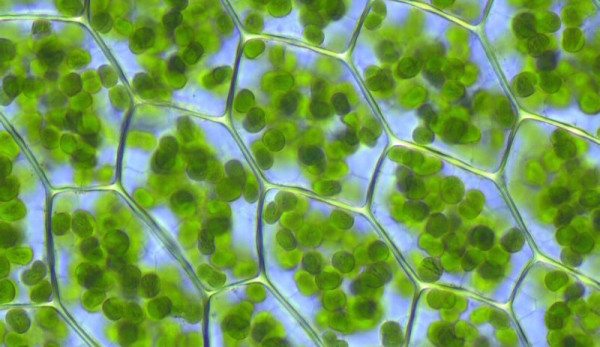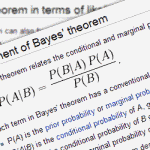The Appropriate Reaction to a Physical Theory of Life
by Dr. Stacy Trasancos
Filed under Science
MIT physicist, Professor Jeremy England, has gotten quite a lot of media attention about his ideas in a 2013 paper in The Journal of Chemical Physics, “Statistical physics of self-replication.”
Quanta Magazine published an essay by Natalie Wolchover coining the work as “The New Physical Theory of Life,” which was republished by Scientific American and Business Insider. England was quoted:
“I am certainly not saying that Darwinian ideas are wrong. On the contrary, I am just saying that from the perspective of the physics, you might call Darwinian evolution a special case of a more general phenomenon.”
His theory explains how 1) groups of atoms in a dynamic environment, like the atmosphere or the ocean, 2) might arrange themselves over time to resonate with the sources of mechanical, electromagnetic, or chemical work from those environments, and 3) produce more entropy back into said environment. The theory seeks to understand the underlying physics of how adaptations evolve and potentially how life began.
The Quanta essay got the attention of Salon writer, Paul Rosenberg, who titled his piece “God is on the ropes: The brilliant new science that has creationists and the Christian right terrified.” Rosenberg sees this work as an “epochal scientific advance” but seems to revel in using it as a “rebuke to pseudo-scientific creationists, who have long mistakenly claimed that thermodynamics disproves evolution.” England’s work shows how the thermodynamically-driven emergence and evolution of life would follow the Second Law of Thermodynamics.
And so it came to pass that Rosenberg’s essay got the attention of his targets.
Creation Ministries International’s Jonathan Sarfati and Carl Wieland tied England’s work to atheism, claiming that atheists “must” believe life came from non-living chemicals. Since specialists are not even close to articulating an exact mechanism, according to them “every so often media headlines trumpet the latest and greatest solution” to protect the atheist theory of evolution. The authors noted that England “is a long way from showing a mechanism by which the huge jump [from chemicals to life] could take place. [Emphasis is theirs.] They see his work as “avoiding the real issue,” that issue being how chemicals became cells.
Casey Luskin from the Intelligent Design community commented at The Blaze in his essay, “Another Challenge from Materialists Who Can’t Explain Origin-of-Life With Science.” He also finds England’s theory to be a shortcoming. “The fundamental problem with England’s theories, and Rosenberg’s polemics, is that sunlight and other forms of energy do not generate new genetic information, nor do they produce new types of biological machines,” he wrote. He thinks the failure of “materialist science” to produce a complete model for the origin of life shows there is a missing insight. “In our experience, only one cause generates new language-based information or machine-like structures: intelligence.”
Most recently, Meghan Walsh of OZY, wrote an essay calling England “The Man Who May One-Up Darwin.” Her interview focused on him as a person more than on his work. Turns out, England is Jewish, prays three times a day, studies the Torah, and spends much of his days changing diapers and brainstorming atop a yoga ball with his infant son.
Of all these essays, I like the first and applaud the last. The other three leave me wincing. So I guess it is my turn. My area of interest is what some would call the intersection of faith and science, although I prefer to think of it as viewing science in the light of faith—thereby untangling myself from mingled disciplines.
Before we even get to the paper, let us dispense with a few things. For one, science cannot punch God out over “the ropes” because God is not made of particles. If you believe in God, you see nature as Creation and science as the study of it. If you do not believe in God, then you see nature as nature and science as the study of it. You say nature. I say Creation, and I view all of it as intelligently designed.
Regarding the Second Law of Thermodynamics, England’s theory is not needed to answer the objections of the Creationists. Rosenberg noted as much. The Second Law states that entropy in the entire universe as a closed system increases with time. Evolution holds that organisms become increasingly more complex, so Creationists see evolution as a contradiction of this law. However, the Second Law refers to the overall entropy in the entire universe, not just the entropy on the earth. The earth is not a closed system and gets energy from the sun to power the increase in biological complexity. England’s proposal adds to this concept by showing how increases in complexity may still be driven by overall increases in entropy output back into the environment.
As for atheists who “must” believe that “life came from non-living chemicals,” should not we all? If living organisms are made of particles, and particles are composed of elements on the periodic table, and the elements obey the laws of physics, then as far as the exact physical sciences are concerned, life can, and did, evolve from non-living particles. The idea that life began as a miracle is an idea that science cannot measure. The idea that God created matter with laws that led to the organization of living things is not a contradiction of faith in God the Creator.
Also, the lack of a complete model for the origin of life should never be wielded as a reason to discredit research into that question. It is well known and accepted that all those mechanisms are not yet defined and that some of them may never be. High school and college biology text books preface the discussion of the history of research into the question of primal abiogenesis by acknowledging that scientists know it is impossible to determine exactly how life arose on earth. There is nothing startling about that honest truth.
A physicist, chemist, or biologist does not ask whether different forms of life were miraculously created because science relies on order and predictability. Should a physical scientist ask a question about the origin of life, he would ask how life originated from particles and evolved as a collection of particles. Then he would devise experiments to test those theories.
Physics is indifferent to life. Physics studies the organization of matter that biology declares living and nonliving. Fundamental to all scientific studies about life is the view that living things differ from non-living things primarily in their degree of organization, which brings us back to the work of Jeremy England. This Jewish father and professor is not “trumpeting” his ideas as a defense of atheism or materialism, nor is he trying to find one single physical characteristic that is unique to the mechanism for the jump from non-life to life (he is explicit about that), and he certainly is not avoiding any real issues.
England is doing what scientists do, especially physicists. Living things replicate, sense, compute, anticipate, respond, and use energy from their environment, and those processes can be studied thermodynamically. So he is considering living organisms strictly as organized systems of particles in which the distance, time, amount, temperature, and energy can be quantified in Newtonian terms to see if thermodynamics adds further understanding of 1) the difference between living and nonliving things and 2) natural selection because Darwinian selection does not fully explain the diversity of life.
England’s work is not intended to show how sunlight and other forms of energy “generate new genetic information” or “biological machines,” as Luskin criticized. There are millions of details between a fundamental physical theory and all the specific mechanisms involved in biological machinery. England’s work, as far as I can tell, is intended to add to the story of how the emergence of complex organization might be possible, how agglomerates of particles might respond to work from the environment and how they might self-reorganize to output more entropy, all based on established laws of physics. Yes, in the long term this understanding could shed new light on mechanisms.
Specifically, England’s approach is to consider organisms as a collection of microstates (arbitrarily defined) forming a macrostate (the organism) in a thermal bath (the environment). If an oscillating external field is applied to the collection of particles (work), just like any collection of particles the system can use this input to break bonds and form new bonds when the chemical equilibrium is disrupted. Chemists describe reversibility and irreversibility in terms of reaction rates and activation energies. Organisms operate far from equilibrium, which must also be taken into consideration.
What is of interest to the question of life-descriptors (i.e. facts that describe what is observed thermodynamically in living things) is how external time-varying work affects the entropy output back into the environment. Organisms cannot un-grow, so the irreversibility of these reactions is of particular interest. Newtonian physics tell us that statistical irreversibility of reactions has a direct relationship to the entropy output. In Darwinian terms, that means organisms that grow well reproduce well. More offspring equals more entropy, but that is not the only factor. In Newtonian terms, the durability of the system and ability to dissipate energy into the environment are also factors.
The physical question is: Why are the particles in a living organism organized the way they are during self-replication? The more “fit” self-replicator would be more efficient at taking work from the environment and producing greater entropy back into the surroundings.
England has derived an equation for what he terms “Driven Stochastic Evolution” in terms of:
- Order: All other things being equal, systems are under a tendency to disorder.
- Durability: As the system experiences fluctuations, there are kinetic activation barriers to bond breakage and formation.
- Dissipation and fluctuation: For irreversible systems (organisms) there needs to be reliably high dissipation of energy back into the environment.
Of course, in reality organisms live amid a constantly fluctuating environment of applied external fields, so they are continually responding.
In inanimate physical systems the tendency to become arranged by the external field is well known. This idea is at the core of nanotechnology, which seeks to harness the self-assembly of macromolecules to effect desired properties and functions. Rearrangement in response to environment is also common in proteins. One could say these processes are driven. Of all the ways organisms in populations can “self-replicate” (reproduce) there may be a driving force. An exciting aspect of England’s work is that it may show how organisms not only evolve, but physically anticipate future evolution by resonating with this driving force.
As test cases for study, England has proposed methods for studying self-replication in nucleotides and cell division in bacteria. There are experiments that can computationally model and test these ideas, so undoubtedly there is more to come not just from England’s group but from other groups interested in physical descriptors of living things.
England was quoted as saying, “You start with a random clump of atoms, and if you shine light on it for long enough, it should not be so surprising that you get a plant.” He is referring to long times, of course. As someone who has studied the almost life-like self-assembling capability of organic and inorganic molecules in an effort to artificially simulate just a few steps of the photosynthetic process, I understand what he means. Assuming plants did not miraculously appear in full maturity then yes, they emerged from organized inanimate matter on a planet illuminated by the sun. And it is exciting to ponder just how this amazing organization occurred! This research could add insight into the hierarchy of the natural world. Where is the hard line between life and non-life? What if there is not one? What if there is a more gradual hierarchy than we thought. Theologically speaking, it is noteworthy that the idea of hierarchies in the created realm is not foreign to Catholic thought.
While I am all for seeing science in the light of faith, I am not for polemics that confuse and accuse. This work shows that scientists indeed rely on the order and predictability of physical laws down to the particles that make up the bodies of living things.
The appropriate reaction to this paper is not jubilation at a perceived victory or accusation of terror in your opponent. Nor should this work be criticized for not detailing all mechanisms involved in biological machinery. Nor is it reasonable to suspect atheist agendas. Nor should anyone ever be criticized for being a methodical materialist when it comes to physical science. The appropriate reaction to this paper is curiosity, appreciation, and anticipation of the next paper.
Related Posts
Note: Our goal is to cultivate serious and respectful dialogue. While it's OK to disagree—even encouraged!—any snarky, offensive, or off-topic comments will be deleted. Before commenting please read the Commenting Rules and Tips. If you're having trouble commenting, read the Commenting Instructions.













